Yet another POSHAN Maah has come and the government has launched POSHAN 2.0 as an extension of POSHAN Abhiyaan. In this blog Ditty Maria Dominic and HR Meena look into the country’s progress towards nutritional targets and the importance of strengthening agri-nutri linkages through nutrition-sensitive extension.
CONTEXT
Eradicating malnutrition is one of the most important global challenges and it is also a key to achieving the sustainable development goals (SDGs). Success in nutrition paves a strong foundation for success in all SDGs. For instance, improved nutrition helps in achieving gender equality, reducing poverty, and improving opportunities. Since independence India has been formulating and implementing many nutritional schemes such as Integrated Child Development Scheme (ICDS), National Nutrition Mission, etc. Nevertheless India continues to be among the countries having more than one-third of its population malnourished (Box 1). With each passing year, the targets of nutritional schemes are growing but with little progress in achieving them. Hence if India is aiming at sustainable development, nutritional issues faced by the country needs to be worked on consistently and more efficiently.
|
Box 1: Malnutrition in India |
WHAT THE DATA INDICATE?
The Prime Minister’s Overarching Scheme for Holistic Nourishment also known as POSHAN Abhiyaan was ambitiously launched by the government to reduce malnutrition rates in the country with specific targets (as given in Table 1) to be achieved by 2022. But the recent National Family Health Survey (NFHS-5) (2019-21) data show that India still lags behind in achieving the set targets. If we look into the consecutive fourth (2015-16) and fifth (2019-21) national family health survey, there has been no impressive decrease in any type of malnutrition throughout the course of the five years between 2016 and 2021.
Only three out of the five major indicators aimed at by POSHAN Abhiyaan, – stunting, wasting and underweight in children of age up to 6 years – have reduced, but in very small percentage points, in the last five years (see Fig. 1). The cases of anaemia have increased both in women and children, which is a serious issue as prevalence of anaemia is the proxy indicator for micronutrient deficiencies and anaemia in children. This cannot be corrected easily in adulthood, potentially leading to cognitive and other impairments. By comparing NFHS-4 and NFHS-5 data it is clearly evident that stunting, wasting and underweight in children have decreased only by 3.5 %, 3% and 4%, respectively, which is much lower than the targets of the POSHAN Abhiyaan. The annual targets set has hardly been achieved in the past three years. Even if it can’t be claimed that things have entirely gone wrong , nationwide, they have not gotten better. The improvements are still well short of what was aimed for.
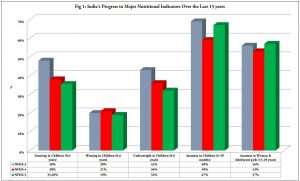
Table 1: Nutritional Targets
| POSHAN Abhiyaan (by 2022) | Sustainable Development Goal 2 (by 2030) |
|
India has been targeting the Sustainable Development Goal 2, through its various nutritional interventions, including POSHAN Abhiyaan. It aims at ending hunger, achieving food security and improved nutrition along with promotion of sustainable agriculture. Ending all forms of malnutrition by 2030 is one of the eight targets of SDG2. The targets referenced in the SDGs refer to WHO’s 2012 resolution to reduce the number of stunted children by 40 per cent by 2025. Achieving this goal would bring the total number of stunted children down from 171 million in 2010 to 100 million in 2025. |
MISSING THE TARGETS – IS COVID-19 THE REASON?
COVID-19 has pushed almost 150-199 million additional people in India into poverty (Ram and Yadav 2021). The pandemic caused food and health system disruptions making the people in developing countries more vulnerable to food and nutritional insecurity. The State of Food Security and Nutrition Report (2021) noted that, throughout 2020 the experience of food insecurity and hunger has exacerbated in Asian and African countries due to the pandemic (FAO, IFAD, UNICEF, WFP and WHO 2021). In India too, the pandemic has caused disturbances in the multiple sectors that are linked to agriculture such as food, health, social and economic sectors. Food supply chains were disrupted, income sources were lost and health sector was saturated making the country more vulnerable to nutritional problems (Gopalan and Mishra 2020; Harris et al. 2020; Kumar et al. 2020).
The closure of schools in India, which are a major source that ensures meal accessibility and immunization services for children, also threatened the nutritional security of children during COVID-19. The government made appreciable efforts to support people in coping with various national and state level programmes – food grain supply through Garib Kalyan Yojana, food kit distribution, direct transfer of Mid-Day Meal cost to primary and upper primary school students, etc. But even before the COVID-19 pandemic hit, the world was already off track with regard to achieving Sustainable Development Goal 2 to eliminate hunger and all forms of malnutrition by 2030. So, the pandemic alone cannot be seen as the cause of India lagging behind in achieving these nutritional targets, rather the pandemic revealed how little progress has been made in nutritional indicators by our country.
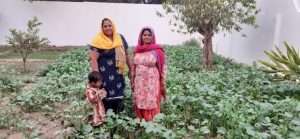 Women from Bassi (UP) in their Nutrition garden © Dr. V. Sangeetha
Women from Bassi (UP) in their Nutrition garden © Dr. V. Sangeetha
IS POSHAN 2.0 THE ANSWER?
Given the under-performance of POSHAN Abhiyaan, implementing another scheme on the same lines is meaningless. Usually the problem of inadequate funding is the issue faced by most of the government programmes, but on the contrary POSHAN Abhiyaan failed to utilize the available funding of 9046 crore (NITI Aayog, 2021). It allocated only around 7411 crore from 2017-18 to 2020. The policy formulation and planning of POSHAN Abhiyaan was well-praised and it was hinged on key pillars of supporting development of services for the vulnerable populations with the help of Technology, Convergence Action Planning, Behavioural Change Communication and Capacity building (PIB, 2018). Experts are of the opinion that inefficiency in the implementation of the scheme led to the under-achievement of set targets.
Though POSHAN has been reinvented as POSHAN 2.0, (Box 2) in order to revisit and pick up the activities for greater progress, experts are both hailing as well as sceptical about POSHAN 2.0. Experts are already doubtful of the higher capacity of POSHAN 2.0. Purnima Menon, Research Fellow, (IFPRI) says, “The programmatic aspects of the Mission POSHAN 2.0 can be analysed for its efficacy only when it comes in the public domain. What appears from the budget is that it is just bundling various schemes. The merger of the supplementary nutrition programme with the POSHAN Abhiyaan is business as usual. There is no increase in the allocations.” Though there are new components, such as the Poshan Tracker app, making AYUSH a major part, and a slightly higher budget than before, experts are critical about this being an ‘old wine in a new bottle’ approach. Also, simply bundling up the schemes alone cannot improve POSHAN Abhiyaan and this can prove to be successful only if there is clarity in roles, objectives and targets, for all the stakeholders involved.
|
Box 2: POSHAN 2.0 |
SCOPE OF THE AGRICULTURE-NUTRITION LINKAGE AND NUTRITION-SENSITIVE EXTENSION
Agriculture and nutrition linkages have been recognised and acknowledged globally as a major tool in eradicating malnutrition. Studies show that agriculture plays a crucial role in achieving adequate nutrition (Pinstrup-Anderson 2006) through various pathways such as enhancing food production, raising income and women empowerment (Kadiyala et al. 2014). International research organizations – Consortium of International Agricultural Research Centers (CGIAR) – have been pointing out the importance of agriculture nutrition linkages through their work on Agriculture for Nutrition and Health (AG4NH). The potential of using agriculture as a tool for better nutrition and health underpins strengthening of nutrition-sensitive extension and integration of nutrition into agricultural policy.
Any intervention or activity that aims at addressing the underlying causes of malnutrition needs to be nutrition sensitive. Nutrition-sensitive agriculture is an approach to agricultural development that puts healthy foods, dietary diversity and food fortification at the forefront of reducing malnutrition and micronutrient deficiencies (FAO). Promotion of home gardens/ nutri-gardens, integration of bio-fortified crops in the food system, behavioural change communication to develop a positive attitude, and higher intention for nutrition-related behaviors are some of the ideas nutrition-extensionists can work on.
The key recommendations of the finalization workshop on ‘Global Capacity Need Assessment (GCNA) for Nutrition Sensitive Agriculture’ organised by the FAO and GFRAS, are notable and these include:
- setting up nutrition as an institutional mandate in EAS organizations,
- mapping and working with nutrition stakeholders beyond the traditional EAS in the agricultural and allied sectors,
- integration of nutrition into academic training in agriculture,
- and capacity building at all levels (FAO and GFRAS 2020).
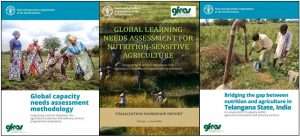 Experts such as Dr Hema Divakar (Technical Advisor, Ministry of Maternal Health & Family Welfare), also insist on this by stating that “ASHA workers’ role is very crucial as they are the first and direct connect. We have to work on building the capacity of ASHA workers, we have to increase their task force, and we all have to think in that direction” (IBEF, 2021). Thus, strengthening the capacity of ASHA workers, by integrating agriculture in their training curricula, is also important. The Agricultural Extension in South Asia Network has published several blogs on the topic of nutrition-sensitive extension (Box 3) and it would be useful to read these while we celebrate POSHAN month now.
Experts such as Dr Hema Divakar (Technical Advisor, Ministry of Maternal Health & Family Welfare), also insist on this by stating that “ASHA workers’ role is very crucial as they are the first and direct connect. We have to work on building the capacity of ASHA workers, we have to increase their task force, and we all have to think in that direction” (IBEF, 2021). Thus, strengthening the capacity of ASHA workers, by integrating agriculture in their training curricula, is also important. The Agricultural Extension in South Asia Network has published several blogs on the topic of nutrition-sensitive extension (Box 3) and it would be useful to read these while we celebrate POSHAN month now.
Although POSHAN Abhiyaan tried to tap into the potential of nutrition-agriculture linkages by including POSHAN Vatikas/nutri-gardens as a feature, its field level implementation and effectiveness is still in doubt. Mostly nutrition-sensitive extension activities see women as the primary target, which is duly supported by the fact that women play a greater role in household’s nutrition and health. But due attention needs to be paid to men and their role in nutrition too (Otieno, Farnworth and Banda 2016). Men’s privilege and power dynamics can influence ability of the women in their households to act on the nutritional knowledge they have been provided.
Enhancing the engagement of men in POSHAN Abhiyaan has been a mandate of POSHAN Pakhwada, but to what extent targeted activities were carried out still remains unclear. The disparities in nutrition within the household can be solved if men are also given right behavioural change communication. Nutrition-sensitive extension can be the ’ ‘Brahmastra’ (or an unfailing weapon) for ending nutritional problems of the country if the right effort is put in.
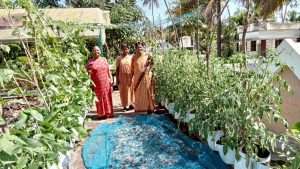 Nutrition garden promoted by Department of Agriculture and Farmer’s Welfare, Kerala at Ernakulam District.
Nutrition garden promoted by Department of Agriculture and Farmer’s Welfare, Kerala at Ernakulam District.
ENDNOTE
Malnutrition is a pressing issue. Investing in nutrition is one of the most cost-effective steps that can be taken for development and prosperity. Every $1 invested in nutrition can generate $16 in returns according to the Global Nutrition Report, 2015. Studies also show that, if developing countries could make progress on nutritional targets, it can escalate the overall economic productivity of the country by 11 per cent. The gaps in India’s nutrition policy and methods for addressing nutrition concerns are highlighted by the Global Nutrition Report 2020. It is pertinent to not overlook the existing gaps in our journey towards attaining the holistic sustainable development goals (SDGs). India cannot afford to backslide on the momentum gained in tackling malnutrition.
The country must invest in nutrition if we are to profit from our demographic dividend. But the existing paradox of underutilisation of the allocated funding throws light on the issues in implementation of the country’s flagship nutritional programme, POSHAN Abhiyaan. There is still much work to be done at the field level. Instead of implementing another nutrition strategy that just bundles up the existing schemes, it is urgent to implement one that represents a radical change in both priorities and attitudes. No policy can succeed without adequate execution strategies.
Better targeting and monitoring should be given central focus. Integration of agriculture into nutritional policy and vice versa should be emphasized (FAO and GFRAS 2022). Nutrition, being influenced by multidimensional factors, key entry points should be identified for implementing nutrition-sensitive interventions. Unless thorough deliberation on the multiple entry points to tackle malnutrition cycle and nutrition-sensitive interventions are given priority, the SDG nutrition targets 2030, will recede even farther.
References
FAO AND GFRAS. 2020. Global capacity needs assessment for nutrition-sensitive agriculture: Integrating nutrition objectives into agricultural extension programmes and policies. Rome: FAO. (Available at: https://www.g-fras.org/en/gfras/1116-full-publication-global-capacity-needs-assessment-gcna-methodology-integrating-nutrition-objectives-into-agricultural-extension-and-advisory-services-programmes-and-policies.html)
FAO, IFAD, UNICEF, WFP and WHO. 2021. The State of Food Security and Nutrition in the World 2021. Transforming food systems for food security, improved nutrition and affordable healthy diets for all. Rome, FAO. (Avaialable at: https://www.fao.org/3/cb4474en/cb4474en.pdf)
FAO and GFRAS. 2022. Bridging the gap between nutrition and agriculture in Telangana State, India – An assessment of capacity within agricultural extension and advisory services. Rome: FAO. (Available at: https://www.fao.org/documents/card/en/c/CB8699EN/)
Gopalan HS and Misra A. 2020. COVID-19 pandemic and challenges for socio-economic issues, healthcare and National Health Programs in India. Diabetes & Metabolic Syndrome: Clinical Research & Reviews 14(5):757-759.
Harris J, Depenbusch L, Pal AA, Nair RM and Ramasamy S. 2020. Food system disruption: Initial livelihood and dietary effects of COVID-19 on vegetable producers in India. Food Security 12(4):841-851.
IBEF. 2021. Mission Poshan 2.0 – Nurturing the future of India. (Available at: https://www.ibef.org/blogs/mission-poshan-2-0-nurturing-the-future-of-india)
Kadiyala S, Harris J, Headey D, Yosef S and Gillespie S. 2014. Agriculture and nutrition in India: Mapping evidence to pathways. Annals of the New York Academy of Sciences 1331(1):43-56.
Kumar MM, Karpaga PP, Panigrahi SK, Raj U and Pathak VK. 2020. Impact of COVID-19 pandemic on adolescent health in India. Journal of Family Medicine and Primary Care 9(11):5484.
Niti Aayog. 2021. Preserving progress on nutrition in India: Poshan Abhiyaan in pandemic times. (Available at: https://www.niti.gov.in/sites/default/files/2022-09/Poshan-Abhiyaan-Monitoring.pdf)
Otieno PE, Farnworth CR and Banda N. 2016. Involving men in nutrition. What works in rural advisory services. Pp. 133. (Available at: https://www.g-fras.org/en/good-practice-notes/27-involving-men-in-nutrition.html?showall=1)
Pinstrup-Andersen P. 2006. Agricultural research and policy to achieve nutrition goals. Pages 353-370 in Poverty, inequality and development. Boston, MA: Springer.
World Health Organization, UN Report. 2021. Pandemic year marked by spike in world hunger (July 12, 2021). (Available at: https://www.who.int/news/item/12-07-2021-un-report-pandemic-year-marked-by-spike-in-world-hunger)
 Ditty Maria Dominic, Research Fellow, Centre for Research on Innovation and Science Policy (CRISP), Hyderabad, India. She can be reached at Email: ditty794@gmail.com.
Ditty Maria Dominic, Research Fellow, Centre for Research on Innovation and Science Policy (CRISP), Hyderabad, India. She can be reached at Email: ditty794@gmail.com.
 Dr. HR Meena, Principal Scientist, ICAR- National Dairy Research Institute (NDRI), Karnal, Haryana, India, He can be reached at Email: drhrms@gmail.com.
Dr. HR Meena, Principal Scientist, ICAR- National Dairy Research Institute (NDRI), Karnal, Haryana, India, He can be reached at Email: drhrms@gmail.com.

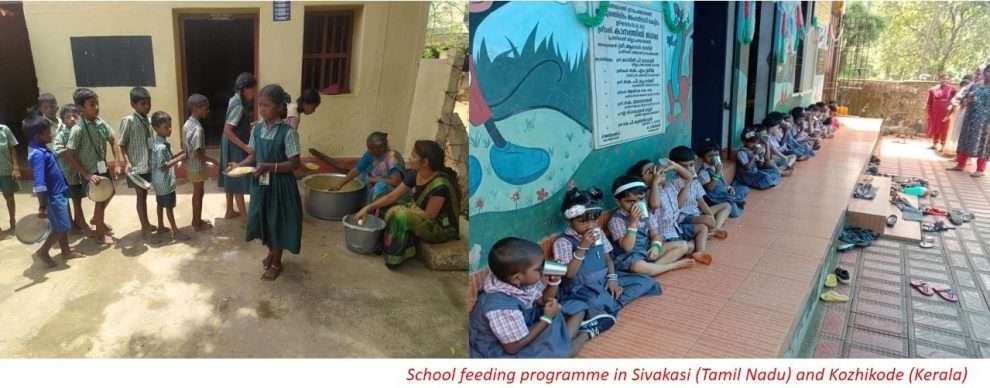

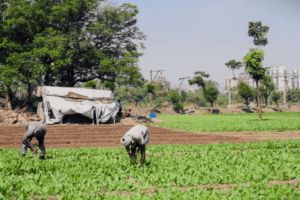

Add Comment